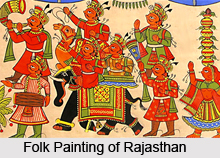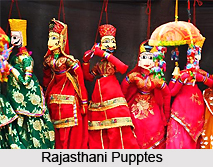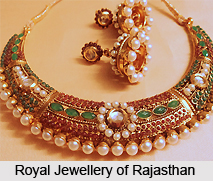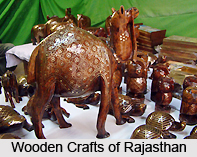 As far as art and craft is concerned Rajasthan is one of the richest states in India. Once a land of brave hearts, it was also famous for its handicrafts. The simple lifestyle of people have honed the creative senses, artistic skills and inspired them to create the most opulent and richest of treasures. The different kinds of arts and crafts in Rajasthan added to the beauty and attraction of this colourful Indian state.
As far as art and craft is concerned Rajasthan is one of the richest states in India. Once a land of brave hearts, it was also famous for its handicrafts. The simple lifestyle of people have honed the creative senses, artistic skills and inspired them to create the most opulent and richest of treasures. The different kinds of arts and crafts in Rajasthan added to the beauty and attraction of this colourful Indian state.
The variations of the art and crafts in Rajasthan are stretched along the length and breadth of the country. As every region has its distinct tradition and culture to follow, every region has its own design, motif and characteristic fabric that weaves its history. The authenticity of the colors, patterns and traditional skills of craft-making are overwhelming. Fashioned by craftsmen with skills preferred over generations and a dedication to their craft bordering on workshop, the items exemplify the motifs and colors of real Rajasthan. Moreover, Rajasthani handicrafts are creative transformation of the spirit of romance and gaiety of the lively native people. Even some of the other art and craft forms of Rajasthan encompass the spirit of the Thar Desert.
The art and craft of Rajasthan developed due to the kind of rulers and royal dynasties that have ruled this West Indian state and their effects were discernable in the art, crafts and culture of Rajasthan. The early history of Rajasthan depicts that the most renowned emperor of the Mauryan Empire, Ashoka had minimal impact in the art and craft of Rajasthan. During his time Buddhist religion flourished. This impact was expressed in Buddhist caves and `stupas` (Buddhist Shrines) at Jhalawar, in Southern Rajasthan. The Royal fervor of Rajputana is alive even today through its great and magnificently built forts, palaces; temples and religious centers that are exemplary of great finesse. Some of the museums in Rajasthan exhibit the objects of different regions that carry the tradition of the ancient Rajasthan or the traditional heritage of the state.
The royal patronage of Mughal Empire and the Rajput rulers had immense impact on the art and crafts in Rajasthan. With the progression of time and the handover of the possession, Rajasthan received modern and contemporary styles and designs. Gradually with the demand of the traditional and modern crafts, the amalgamations of different style were introduced. Each period of history was the witness of the contribution to the art and crafts in Rajasthan. The history of Rajasthan reveals that the kings and their nobles were patrons of art and crafts and they encouraged their craftsmen of different sectors ranging from wood and marble carving to weaving, pottery and painting. The tradition was enriched with the devotion of the artisans and with the type of fusion that were created during the time in all parts of Rajasthan.
Dance forms an integral part of Rajasthani art. The major folk dances of Rajasthan include Bhavai, Ghoomar, Kachhi Ghodi, Chari, Kalbeliya, Gair, Kathputli and Terahtaali. The dances, found in limitless variations in Rajasthan, punctuate its barrenness, turning the land into a fertile basin of color and creativity and are an expression of human emotion as much as the folk music. In addition to that there are various other art and crafts that are hugely famous in not only India but all over the globe incorporate Blue Pottery, Textiles, Wooden and Sandalwood Craft, Paintings, Toys and Gifts, Indian Jewellery, Thewa Art, precious & semi precious Stones, Quilts (Razais) and Block Prints (Madups- Covers), leather and metal Craft, Marble Stone Crafts, wooden furniture, paintings, leather craft and sculpture.
The art and craft in Rajasthan include folk paintings in Rajasthan. Chittorgarh is the main center for folk paintings and the most popular form of folk paintings are the Phad paintings. Jaipur in Rajasthan is bona fide centre for Rajasthani Jewellery which flaunts a wide variety of enameled jewelries to semi precious stone jewellery. Jaipur is renowned for the classic designs that catch the fancy of the tourists and the local people.  The cultural tradition of Rajasthan unveils that the state is famous for its terracotta traditions. Though the famous Blue Pottery of Jaipur has its roots in China, it came down to Rajasthan through the Mughal emperors. Another eye catching art culture of Rajasthan is Rajasthani Jootis or Mojaris (Leather Sandals) that display superb embroidery and brilliant use of colours and designs. Besides these the `nagrai chappals` are also widely available in Rajasthan. Jaipur and Jodhpur are traditionally known for these exquisite foot wears. Other leather items, such as, handbags, wallets, belts, jewellery boxes and even souvenirs are also available.
The cultural tradition of Rajasthan unveils that the state is famous for its terracotta traditions. Though the famous Blue Pottery of Jaipur has its roots in China, it came down to Rajasthan through the Mughal emperors. Another eye catching art culture of Rajasthan is Rajasthani Jootis or Mojaris (Leather Sandals) that display superb embroidery and brilliant use of colours and designs. Besides these the `nagrai chappals` are also widely available in Rajasthan. Jaipur and Jodhpur are traditionally known for these exquisite foot wears. Other leather items, such as, handbags, wallets, belts, jewellery boxes and even souvenirs are also available.
Sculpture in Rajasthan is hugely displayed in places like Dilwara Temple in Mount Abu or another Jain temple at Ranakpur. The architectures of these splendid buildings are truly impressive. During the Mughal era the red sandstone was widely used to build a variety of monuments. Moreover Rajasthan holds the tradition of making puppets and dolls that are painted in colours and decorated in attractive dresses. The toys are made in Bassi are inspired by local legends. The little cosmetic box called Shringardani is traditionally given to a bride on her wedding day and is a toy for children as well. Wooden toys made in Udaipur are very popular. Some other traditional articles like surahis, pots and cylindrical jars and decorative items like ash-trays, tiles, flower pots, lamp stands, beads, ear rings, soap dishes, jugs, mugs and door knobs are created exclusively maintaining the tradition and creativity. The artistry displayed in marble carvings, miniature paintings or frescoes all shows the creative genius of the craftsmen of yesteryears.
The art and crafts in Rajasthan also carry the distinct quality of portraying the authentic and unique style in paintings. The Rajasthani medieval paintings have their own unique styles with the depiction of the hills and valleys, deserts, places and forts, gardens, court scenes, religious processions; and the highlighting scenes from the life of Lord Krishna were the recurrent themes of these paintings. Rajasthan treasures the painting like the Ragamala paintings and paintings based on Geeta Govinda. The artists of Rajasthan were practicing their art of miniature painting since 16th century and were later employed by the Mughal courts including the emperor Akbar.
 The art and craft in Rajasthan have been developing since the medieval era, as many emperors have ruled Rajasthan and the state was overwhelmed by the tradition that were developed from the past dynasties and merged them with their own. The palaces are woven with rich history intricate with sagas of illustrious dynasties. The land describes the prosperity of paradoxes, from rigid codes of chivalry to tales of unbridled passion; from shimmering lakes to endless desert vistas; from stately pleasure places to labyrinthine bazaars. The extreme passion and the mesmerizing swirl of colors and an extravaganza of warmth and rustic pleasure of simplicity attract the tourist attention to indulge in all the forms of enjoyment and traditional uniqueness. The Amber Fort of Jaipur is world famous for its Architecture, Elephant Ride and the forts are the additional pleasures that are attract the tourist attention. The Umaid Bhawan Palace of Jodhpur is one of the attractions at Jodhpur including Junagarh Fort, Bikaner and other famous places like Ajmer, Alwar, Bikaner, Chittorgarh, Jaipur, Jaisalmer, Jodhpur, Kota, Mount Abu, Pushkar, Ranthambore and Udaipur. Moreover the traditional art and craft in Rajasthan are the major eye catching fixation that the tourists from all over the world cherish.
The art and craft in Rajasthan have been developing since the medieval era, as many emperors have ruled Rajasthan and the state was overwhelmed by the tradition that were developed from the past dynasties and merged them with their own. The palaces are woven with rich history intricate with sagas of illustrious dynasties. The land describes the prosperity of paradoxes, from rigid codes of chivalry to tales of unbridled passion; from shimmering lakes to endless desert vistas; from stately pleasure places to labyrinthine bazaars. The extreme passion and the mesmerizing swirl of colors and an extravaganza of warmth and rustic pleasure of simplicity attract the tourist attention to indulge in all the forms of enjoyment and traditional uniqueness. The Amber Fort of Jaipur is world famous for its Architecture, Elephant Ride and the forts are the additional pleasures that are attract the tourist attention. The Umaid Bhawan Palace of Jodhpur is one of the attractions at Jodhpur including Junagarh Fort, Bikaner and other famous places like Ajmer, Alwar, Bikaner, Chittorgarh, Jaipur, Jaisalmer, Jodhpur, Kota, Mount Abu, Pushkar, Ranthambore and Udaipur. Moreover the traditional art and craft in Rajasthan are the major eye catching fixation that the tourists from all over the world cherish.
The art and crafts of Rajasthan has its own bucolic as well as aesthetic appeal that has made the place of a source of fascination, appreciation, visual and artistic pleasure. In the present era the structures defy time to tell the story of gallantry, courage and tragedy of the bygone era and its story of survival in the harsh Thar Desert.



















